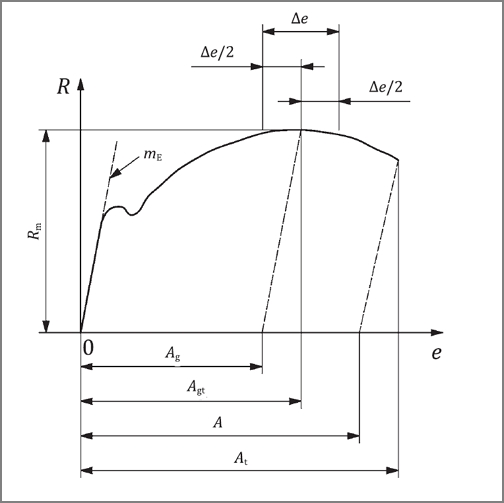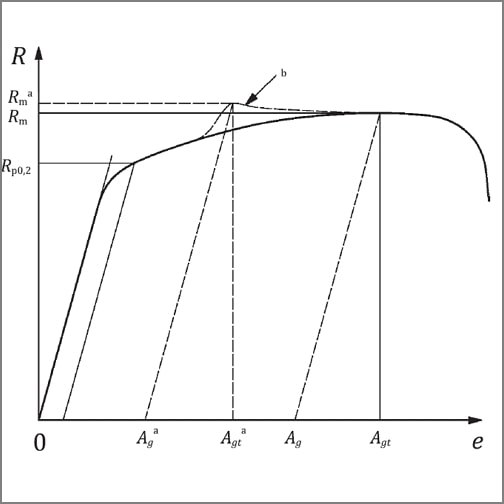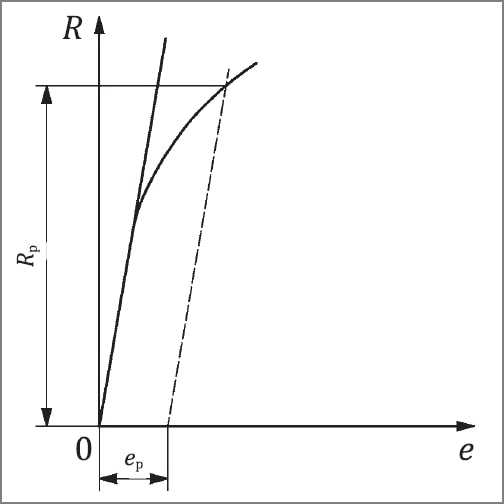


Company: TeMeCo
Tensile test according to ISO 6892
The two methods of the standard
The test standard ISO 6892-1 is related to metallic materials. It is similar to ASTM E8/E8M but not identical. It describes three different test procedures:
Method A describes the mode of strain control.
A1 is in closed loop,
A2 in open loop.
Method B describes the stress-controlled mode.
ISO 6892-1 deals with the tensile test at room temperature
ISO 6892-2 deals with the tensile test at elevated temperature
Tensile test according to ISO 6892-1
Method A (strain-controlled test procedure)
Method A1: “closed Loop”
Here, the test is carried out with a closed control loop. An extensometer is required for this. It is controlled to the strain rate of the extensometer signal.
Method A2: “open Loop”
Here, testing is carried out with an open control loop.
The strain rate is estimated via the parallel sample length:
Crosshead speed v = Lc * dε/dt
From the start to the end of ReH, Rp and Rt applies:
Strain control with dε/dt = 0.000 07 s-1 ±20%
After that (ReL, Ae, Rm, Ag, Agt, A, At, Z) applies:
Strain control with dε/dt = 0.00 2 s-1 ±20%
Method B ( stress-controlled execution of the experiment)
In method B, the initial test speed is made dependent on its elasticity.
Until Rp0.2 is determined, the following applies:
- When E < 150 GPa: –> 2 to 20 MPa/s
- When E ≥ 150 GPa: –> 6 to 60 MPa/s
From Rp0.2 applies:
- Strain rate < 0.008 s−1.
Strain control explained in 7 steps:
Step 1:
Elongation = change in length / initial length.
If the initial length L0 = 100mm and the length change = 1mm, then the strain is ε= 1/100 = 0.01
Step 2:
Strain rate dε/dt = change in strain / change in time.
If the test is performed with a constant strain rate of 0.01 s-1, this corresponds to 1mm/s (=60mm/min) at this moment.
Step 3:
If the sample is stretched 10%, then L=110mm.
At this point, 1mm extension still makes up 1/110.
The strain rate is therefore dε/dt= 1/110 = 0.00909
Conclusion: The test speed slows down.
Step 4:
However, since one wants to get faster and faster during the test, constant strain rates are defined in ISO 6892, e.g. 0.00025 s-1 .
Step 5:
When at L=100mm dε/dt = 0.00025,
then the test speed is v = 100 mm * 0.00025 s-1 = 0.025mm/s =1.5mm/min.
And with L=110mm dε/dt = 0.00025,
the test speed isv = 110 mm * 0.00025 s-1 =1.65mm/min.
Step 6:
Since this speed is relatively slow, according to the standard one may accelerate to a higher speed (0.0067 s-1 ) after determining the elasticity characteristics.
Step 7:
Since the elastic range is usually not so large, let’s assume that the specimen is still about the same length according to the elastic characteristic values, i.e. 100mm. Then dε/dt = 0.0067 s-1 corresponds to a speed of approx. v=40mm/min.
If at some point the sample length becomes L=150mm, then v = 60mm/min.
So the traverse speed becomes faster and faster.
Discussion
Method
The test speed is a long discussed topic of this standard. Whereas in earlier standards it was simple speeds in mm/min, in ISO 6892 it is the strain rates. The strain rate is the strain per unit of time. The standard contains a large number of conditions for which different elongation rates are to be applied. A detailed reproduction of these conditions is omitted here and reference is made to the standard.
However, we want to shed light on a few practical aspects: At the beginning of the tensile test, characteristic values such as modulus of elasticity, yield strength and proportional limit are determined. Especially with hard materials with a high modulus of elasticity, a considerable level of force is achieved very quickly. In order to obtain a sufficient number of measuring points, the tensile test is run slowly in this area. So that a test does not take long, it is accelerated afterwards. Now it depends on the material whether you see this transition on the stress-strain curve. If the material is strain rate sensitive and you switch speeds quickly, you will see a kink in the curve. This is unsightly for the curve, but provides information on the strain rate sensitivity of the material. With a slower speed change, this kink can be made to disappear and the curve looks “nice”.
The question of right or wrong swings to the application of the measurement results. What are they used for? What strain rate is present at the location for which you want to make a statement with the measured value?
This question leads us to another topic, standards in general. ISO 6892 is a rather general standard that does not deal with the intended use of the determined values. It is focused on minimising the scatter of measurement results. Standards, on the other hand, which are written by the car or aircraft industry, for example, are more application-oriented.
